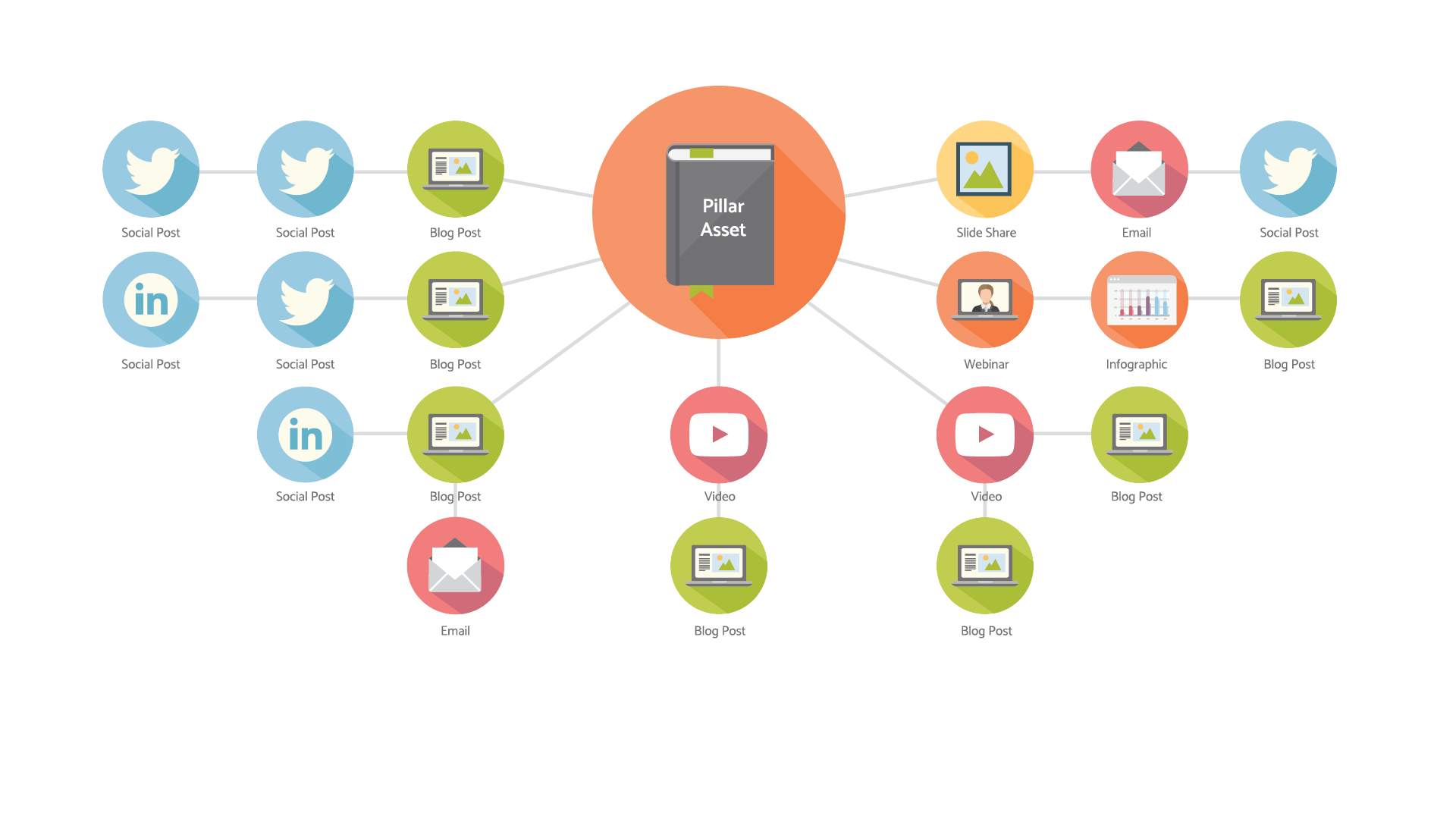One of the biggest mistakes B2B brands make when kicking off a content marketing program is creating and publishing multiple, disconnected pieces of content without a common goal and consistent messaging. This is not only inefficient, but also not a very strategic way to generate leads. A hub and spoke content model, in which you build a large pillar asset and many derivative pieces from that can help you streamline your content creation, save money and improve content effectiveness.
A pillar asset is simply a substantive, in-depth piece of content that is valuable enough to gate behind a form in exchange for prospect contact information. It can come in the form of a guide, research report, white paper or e-book. This type of content doesn’t come together overnight, rather it is a long-term investment. However, this one piece of content can serve as the glue and main call to action for a fully integrated campaign to carry your lead generation efforts for months. The ROI you can get from this one asset surpasses the effort to manage multiple, smaller projects.
When it comes to the effort needed to create a pillar asset, the two biggest concerns companies have are insights and the investment. Before we dive into the positive ROI you can achieve with a content pillar asset, let’s break down these common barriers.
Insights: The thought of creating an in-depth asset – whether a 3-page guide or a 10-page e-book – can be daunting. Our clients often wonder if they have enough insights and expertise to create an engaging piece of content their audience is willing to download.
The answer is yes!
To determine what to create your campaign around, it is important to take time uncovering white space in your market— whether through voice of customer research or original market research. Understanding what information your target audience needs can help you prioritize what topics to cover. And then show off your expertise in how they can operationalize the insights and how it can help them do their jobs better—don’t be afraid to be bold.
Investment: Time and/or budget are also often hurdles to creating a pillar asset. And the reality is, it will take time and resources to create a strong, valuable piece of content. But if built properly, you will be able to break it out and repurpose it into many derivative assets to fuel an entire 6 month-long campaign.
Take for instance the e-book Inprela published earlier this year, “The B2B marketer’s guide to driving more business impact.” From this one piece of content, we produced:
- Five derivative blog posts—and counting
- Social posts
- Programmatic display & AdWords campaigns
- New business presentations
- Email campaigns
- Speaking engagement abstracts
This campaign has already resulted in 235 downloads and 81 high quality leads.
Making your content pillar asset work for you.
Once the content is created, one of the other mistakes companies make is not making the investment in content promotion. Don’t let your hard work be for nothing. Repurposing and reusing content is very effective and economical. Here are some of the ways you can put your content to work for you to achieve the greatest ROI.
Derivative content: All derivative content and promotions should include CTAs to download the larger asset. Here are some ways you can slice and dice your pillar asset and recommendations on which channels to use.
Earned: Pitch angles from the pillar asset to the trade press to secure bylined articles and Q&As. This might mean highlighting a case study that was part of your asset or simply covering one section.
Owned: Self-publish blog posts or articles and develop mini-videos or infographics with snippets of information from the pillar asset that can be published on your website or promoted via your social channels.
Paid: Evaluate media sponsorships that would guarantee clicks and downloads. LinkedIn Sponsored Content is another great channel to use to deliver the content to the right audiences. And with LinkedIn Lead Gen campaigns, you can generate leads directly from the platform.
Sales enablement: Showcasing your expertise in a content pillar can serve as a strong sales tool as well—for current and future customers.
Current customers: Pull out powerful messaging or data and include it in sales presentations, where relevant, and then have your sales representative follow up with the full asset after the meeting. You can also create email templates for your reps to help reactivate dormant customers.
Future customers: If you gate the asset, not only can you measure engagement, it also allows you to capture email addresses. Engage your sales team to follow up with those who have downloaded the content. Gathering emails also allows you to grow your database for future marketing and targeting campaigns.
Making the investment in creating a pillar content asset can be a strong component of your 2019 marketing plan. And putting the effort in to promote it can provide an even bigger ROI. Let’s connect on how you can get started—email us at connect@inprela.com.



